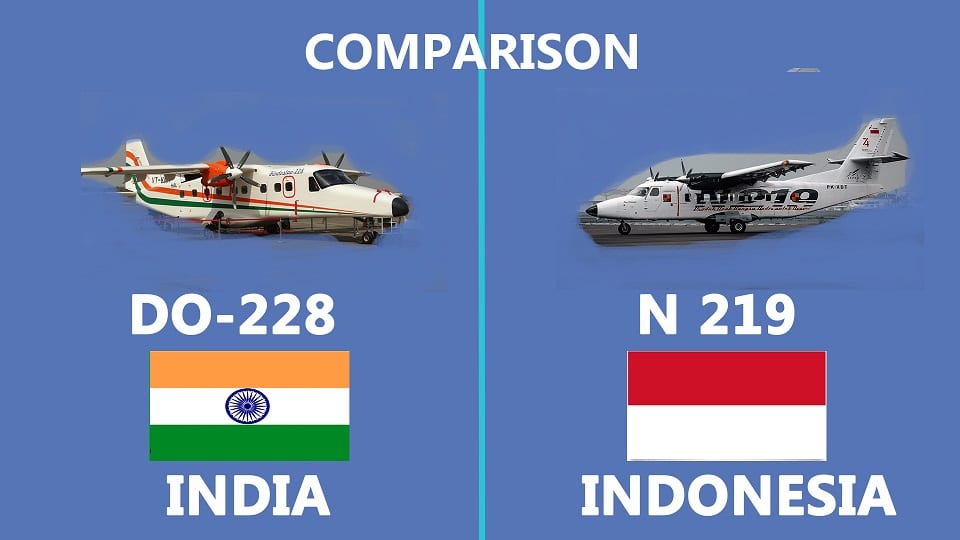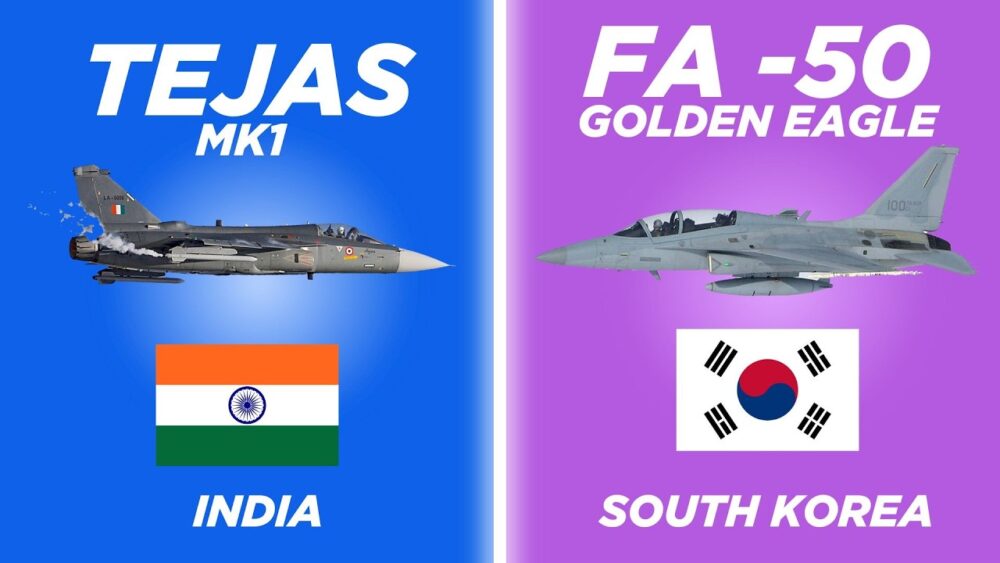Aircraft comparison
Comparison between Dornier-228 v/s Indonesian N219

In this article, we’ll talk about two different types of airplanes: the Dornier-228 from India and the N-219 from Indonesia.
Indian Dornier-228 specification
The HAL Dornier 228 is a twin-turboprop utility aircraft that was created by Hindustan Aeronautics Limited (HAL), an Indian state-owned aerospace and defense firm, in collaboration with Dornier Flugzeugwerke, a German aircraft manufacturer.
The Dornier 228 is a versatile aircraft that can perform a number of tasks, such as passenger transport, transporting cargo, and conducting maritime surveillance. To support these diverse missions, it is outfitted with a variety of equipment and sensors, including radar, a searchlight, and a forward-looking infrared (FLIR) camera.
The first Dornier 228-100 entered service in Norving’s fleet in July 1982 after being developed in the 1980s. It is currently in use by numerous military and civilian operators all over the world, including the Indian Coast Guard and the Nepal Army. The Dornier 228 has a maximum seating capacity of 19 passengers and a ferry range of about 2,363 kilometers.
Comparison of global 7500 v/s Gulfstream 700(Opens in a new browser tab)
Indonesia’s N219 specification
Let’s speak about the N219 aircraft, which is a new generation multi-purpose aircraft with the largest cabin cross-section in its class, a proven and efficient engine, a modern avionics system, fixed tricycle landing gear, and a wide cargo door to make changing aircraft configuration easier. As a result, N219 Nurtanio is designed to give operators with technical and economic benefits.
The Indonesian N219 is a regional turboprop aircraft being developed by Indonesian aircraft manufacturer PT Dirgantara Indonesia (PTDI). It is intended to replace Indonesian airlines’ outdated fleet of Fokker 27 and Fokker 28 aircraft. The N219 has a ferry range of around 1,533 kilometers and it has a seating capacity of around 19 to 21 passengers.
The N219 project began in 2015, and the prototype debuted on 16 August 2017. It is anticipated that the aircraft, which is now in the testing and certification phase, would soon begin flying for Indonesian airlines.
This aircraft may be employed for a variety of missions, including passenger and troop transport, freight and medical supplies, surveillance, and patrolling.
The selling price of N219 aircraft, according to PTDI’s Production Director, Arie Wibowo, is in the region of US $ 6 million per unit, or roughly Rp 81 billion.
She fell 10,000 ft to earth strapped to a seat and lived..!!(Opens in a new browser tab)
Both the Indonesian N219 and the HAL Dornier 228 are regional transport aircraft used for short-haul flights. However, there are several key differences between these two aircraft:
- Manufacturer: The HAL Dornier 228 was developed by Hindustan Aeronautics Limited in partnership with Dornier Flugzeugwerke, while the Indonesian N219 is being developed by PT Dirgantara Indonesia.
- Size: The N 219 aircraft is 54 ft 1 inch in length, 64 ft 0 inch in wingspan, and 20 ft 3 inch in height. The Do 228 has a length of Length 54 ft 4 in, a Wingspan of 55 ft 8 inches, and a Height of 15 ft 11 inches.
- Design: The Dornier 228 is a high-wing aircraft with twin turboprop Honeywell engines, whereas the N219 is a similar high-wing aircraft with twin turboprop Pratt & Whitney engines.
- Capacity: The Dornier 228 can seat up to 19 passengers, whereas the N219 can accommodate 19-21 passengers.
- Ferry Range: The Dornier 228 has a ferry range of approximately 2,363 kilometers, while the N219 has a range of around 1,533 kilometers.
- Role: The Dornier 228 is a multi-role aircraft that can perform passenger transport, cargo transport, and maritime surveillance. The N219 is primarily designed for regional transport use.
- Status: The Dornier 228 has been in service for several decades and is currently in use by a number of military and civilian operators across the world. The N219 is currently undergoing testing and certification and is anticipated to enter service with Indonesian airlines in the near future.
- Dornier 228 aircraft has a range of 396 km and Indonesian N 219 has a range of up to 890 km.
- As of now, HAL has built nearly 125 aircraft and Indonesia N 219 has now received 120 aircraft orders from regional airlines
- The HAL-built Dornier 228 and Indonesia’s N 219 aircraft have a price range is 6 million USD in regional cost per unit.

Aircraft comparison
Comparison of the Indian built Tejas MK1A vs South korean FA 50

Today, we’ll explore two remarkable light combat aircraft: the Tejas MK1A and the FA-50 Golden Eagle. Both fighters are designed for versatility, making them ideal for various missions, from air-to-air combat to ground support.
The Tejas MK1A, developed by Hindustan Aeronautics Limited (HAL) in India, and the FA-50, a product of Korea Aerospace Industries (KAI), are both advanced aircraft equipped with modern technology and features.
10 Fascinating Facts About India’s AMCA Fighter Jet
In this Article, we will compare these two fighters in terms of their specifications, performance, capabilities, and roles in modern air forces. Let’s dive in and see how they stack up against each other!
Tejas is the second supersonic combat aircraft developed by Hindustan Aeronautics Limited (HAL), following the HF-24 Marut. It took its first flight in 2001 and was inducted into service with the Indian Air Force (IAF) in 2015. Currently, Tejas holds the distinction of being the smallest and lightest aircraft in its class of supersonic combat jets.
On the other hand, the FA-50 is South Korea’s first indigenous supersonic aircraft and is one of the few supersonic trainers in the world. Development of the T-50 began in the late 1990s, with its maiden flight taking place in 2002.
Russia Seeks Talks with India, Offers Tu-160 Bombers at Unbeatable Prices
The FA-50 boasts a higher production rate compared to the Tejas. Over the past 15 years, Korea Aerospace Industries (KAI) has produced nearly 200 variants of the FA-50, while Tejas has seen a lower production output.
In terms of international sales, the FA-50 is actively in service with multiple countries, including Indonesia, Iraq, the Philippines, Thailand, and Poland. Notably, Malaysia opted for the FA-50 over the Tejas, citing the FA-50’s strong service record as a key factor in their decision.
Here’s a SPECIFICATION of the Tejas and FA-50
Length: The Tejas measures 13.2 m (43 ft 4 in), making it slightly longer than the FA-50, which is 13.14 m (43 ft 1 in).
Max Takeoff Weight: The Tejas has a maximum takeoff weight of 13,500 kg (29,762 lb), compared to the FA-50’s lighter weight of 10,722 kg (23,638 lb).
Fuel Capacity: The Tejas has an internal fuel capacity of 3,060 liters (810 US gallons), while the FA-50 has a slightly lower internal fuel capacity of 2,655 liters (701 US gallons).
Powerplant: Both aircraft are powered by General Electric F404 turbofan engines, but the Tejas utilizes the F404-GE-IN20 variant with 48.9 kN (11,000 lbf) thrust dry and 85 kN (19,000 lbf) with afterburner. The FA-50 features the F404-GE-102 variant, producing 53.07 kN (11,930 lbf) thrust dry and 78.7 kN (17,700 lbf) with afterburner.
Maximum Speed: The Tejas has a maximum speed of 2,220 km/h (Mach 1.8), which is significantly faster than the FA-50’s maximum speed of 1,837.5 km/h (Mach 1.5).
Combat Range: The Tejas has a combat range of 739 km (459 mi), whereas the FA-50 has a much longer range of 1,851 km (1,150 mi).
Hardpoints: The Tejas features 9 hardpoints with a total capacity of 5,300 kg, while the FA-50 has 7 hardpoints capable of carrying up to 5,400 kg of payload.
Cost: The Tejas is priced at approximately $40 million per unit, whereas the FA-50 ranges between $30 million to $40 million per unit, making the FA-50 potentially more cost-effective depending on the variant chosen.
Weapons
When it comes to weaponry, the Tejas MK1A offers a wider range of options compared to the FA-50 Golden Eagle. The Tejas MK1A is equipped with beyond-visual-range (BVR) missiles, allowing it to engage targets at greater distances, enhancing its combat effectiveness in air superiority missions. Additionally, it can carry precision-guided munitions for accurate strikes against ground targets, as well as standoff weapons, which can be launched from a distance to minimize exposure to enemy defenses. This diverse armament enables the Tejas to perform a variety of roles, from air-to-air combat to ground support.
In contrast, the FA-50 also features a respectable armament capability but has a more limited selection. It can carry air-to-air missiles like the AIM-9 Sidewinder and AIM-120 AMRAAM, as well as precision-guided bombs. However, its focus leans more toward close air support and light strike missions rather than the extensive versatility that the Tejas offers.
Naval Variant
The Tejas Mk1A has a naval variant designed for carrier operations, which is still in development. This version includes upgrades like a nose droop for better visibility during landings and takeoffs, a strengthened undercarriage, and an arrestor hook for safe landings on aircraft carriers.
In contrast, the FA-50 does not have a naval variant. While it’s versatile for different missions, it’s not designed for carrier operations, limiting its flexibility compared to the naval Tejas, which can operate from both land and carriers.
-

 Aviation2 months ago
Aviation2 months agoBoeing confirms 797: A New Era for Mid-Size Aircraft
-

 Aviation2 months ago
Aviation2 months agoMicrosoft Flight Simulator Raises $3 Million to Bring Back the An-225 Mriya
-

 Aviation2 months ago
Aviation2 months agoLockheed and Tata Team Up to Build C-130J MRO Facility in India
-

 Airlines2 months ago
Airlines2 months agoQantas Engineers Stage Walkout Over Cost of Living Concerns
-

 Airlines2 months ago
Airlines2 months agoQatar Citizens Can Travel to the United States Without a Visa
-

 Aviation2 months ago
Aviation2 months agoBoeing Offers 25% Pay Increase & Promise to Build Next Plane in Seattle
-

 Aviation2 months ago
Aviation2 months agoQatar Airways bans these new Electronic Devices on plane
-

 Airlines2 months ago
Airlines2 months agoEmirates Ends 28-Year Singapore-Melbourne Fifth Freedom Route








